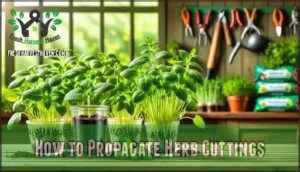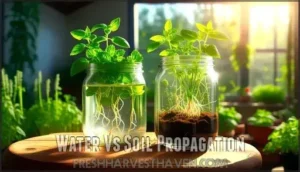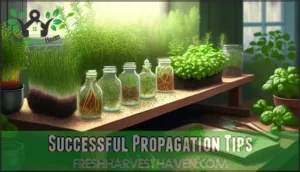This site is supported by our readers. We may earn a commission, at no cost to you, if you purchase through links.

Choose soft-stemmed herbs like basil, mint, or oregano for easiest success.
Cut below a leaf node, remove lower leaves, and place in a glass of water or moist soil mix.
Change water every few days or keep soil damp but not soggy.
Most cuttings develop roots within 2-3 weeks.
It’s like getting free plants from your existing garden – one basil plant can become a dozen new ones with minimal effort.
The secret lies in choosing the right cutting technique and timing for each herb variety.
Table Of Contents
- Key Takeaways
- Propagating Herb Cuttings
- How to Propagate Herb Cuttings
- Choosing Right Herbs
- Water Vs Soil Propagation
- Successful Propagation Tips
- Frequently Asked Questions (FAQs)
- Can you grow herbs from cuttings?
- How do you propagate a herb cutting?
- What herbs can be propagated by cuttings?
- Can You propagate a plant with a cutting?
- What is a benefit of propagating herbs from cuttings?
- How do you propagate new herbs?
- Will herb cuttings root in water?
- How to propagate herbs?
- Is propagating herbs from cuttings a good idea?
- How long does it take to propagate herbs?
- Conclusion
Key Takeaways
- Choose soft-stemmed herbs like basil, mint, and oregano – they’ll root much faster in water than woody varieties like rosemary, giving you quicker success and fewer failures
- Cut 4-6 inch stems below a leaf node and strip lower leaves – this focuses the plant’s energy on developing roots instead of supporting excess foliage
- Change water every few days or keep soil damp but not soggy – proper moisture prevents bacterial growth in water and root rot in soil while encouraging healthy root development
- Expect roots within 2-3 weeks for most herbs – you’ll see tiny white roots emerging from nodes, and once they’re established, you can transplant or keep growing in your chosen medium
Propagating Herb Cuttings
You’ll love how herb propagation turns one plant into many without spending extra money at the garden center.
Taking cuttings from your favorite herbs gives you fresh plants that grow faster than seeds and taste exactly like their parent plant, allowing for complete concepts of plant reproduction to be easily understood.
Benefits of Propagation
Through herb cutting propagation, you’ll discover a treasure chest of gardening benefits that’ll make your wallet and garden smile.
Turn one plant into dozens without spending a dime at the nursery!
This simple plant propagation technique transforms one herb into many, creating endless possibilities for your culinary adventures.
Here’s why herb propagation is a game-changer:
- Cost Savings – Skip the nursery and grow unlimited herbs from existing plants
- Garden Expansion – Multiply your favorite varieties without breaking the bank
- Sharing Herbs – Gift cutings to friends and neighbors for instant garden karma
- Self-Sufficiency – Keep fresh herbs flowing year-round, even indoors
- Genetic Preservation – Clone your best-performing plants with identical traits
Herb cuttings root faster than seeds and maintain the exact flavor profile you love.
Tools and Techniques
Getting started with herb cutting propagation requires sharp cutting tools like clean scissors or pruning shears—dull blades damage plant tissue.
Use sterilization methods with rubbing alcohol to prevent disease spread. Take 6-10 inch cuttings with nodes for rooting herb cuttings.
Choose rooting mediums wisely: water for soft herbs, soil for woody ones. Hormone use boosts success rates, while humidity control prevents wilting during propagation techniques.
Proper care also involves using the right cutting tools herbs to promote healthy plant growth.
Suitable Herbs for Propagation
Now that you’ve got the right tools, choosing the right herbs matters most for propagation success.
Softstemmed herbs like basil and mint practically root themselves in water, while woody types like rosemary need patience and soil.
Your herb selection affects rooting methods—think plant cloning made easy!
Best herbs propagate when you match stem types to technique.
These gardening tips turn propagate herbs cuttings into a breeze, making rooting herb cuttings feel foolproof with proper herb propagation methods.
How to Propagate Herb Cuttings
Ready to master herb cloning? You’ll need cutting tools, patience, and the right technique. Success starts with taking healthy 6-10 inch stems from your favorite herbs, then nurturing them into thriving plants.
Here’s your step-by-step roadmap:
- Prep your cuttings: Use clean cutting tools to snip stems with nodes, removing lower leaves but keeping 4-6 at the top.
- Choose your method: Try water propagation herbs for soft stems or soil for woody varieties with rooting hormone herbs.
- Provide proper root care: Maintain humidity, bright indirect light, and plant nutrition once established.
Understanding herb propagation basics is essential for achieving high success rates with your cuttings.
Choosing Right Herbs
Choosing the right herbs for propagation makes all the difference between quick success and frustrating failures.
You’ll find that soft-stemmed herbs like basil and mint root easily in water, while woody herbs such as rosemary need soil and a bit more patience to achieve quick success.
Soft-Stemmed Herbs
Soft-stemmed herbs are your best bet for herb propagation success.
Softwood cuttings from basil, mint, and parsley root fast in water propagation, developing visible roots within two weeks.
Their flexible stems make stem preparation simple—just cut below a node for proper node exposure.
These herbs respond well to basic herb cloning techniques without needing rooting hormone or complex cutting storage methods.
For successful propagation, understanding herb propagation methods is vital to achieve desirable results.
Woody-Stemmed Herbs
Unlike their softer cousins, woody herbs like rosemary, sage, and thyme need tougher love.
These sturdy plants require semi-hardwood cuttings and patience—think marathon, not sprint.
Here’s your woody herb propagation game plan:
- Rosemary care demands well-draining soil and rooting hormone for best results
- Sage propagation works best with 4-inch cuttings taken from non-flowering stems
- Thyme cloning succeeds when you keep humidity high but avoid waterlogged conditions
Herbaceous Stems
Herbaceous stem cuttings herbs work like magic for propagate herbs easily. These soft, green stems from basil and mint offer fast rooting herbs potential.
Stem Selection focuses on 4-6 inch segments below nodes for ideal Root Stimulation. Cutting Preparation involves removing lower leaves while Node Exposure encourages adventitious roots.
Spring timing delivers herb cutting success through cloning herbs cuttings techniques. For optimal results, consider using rooting hormone techniques to enhance the rooting process.
Semi-Woody Stems
Featuring firm yet flexible stems, semi-woody herbs like rosemary, sage, and thyme excel at stem cuttings during late summer.
These semihardwood cuttings offer excellent propagate herbs easily opportunities with proper technique.
- Stem Selection: Choose 8-10cm non-flowering shoots from current season’s growth
- Node Exposure: Remove lower leaves and apply rooting hormones for root enhancement
- Cutting Timing: Take cuttings when stems show intermediate firmness for herb cutting success
Water Vs Soil Propagation
When you’re ready to root your herb cuttings, you’ve got two main paths: water or soil.
Both methods work great, but each has its own perks depending on what herbs you’re working with and how patient you feel, especially considering the complete concepts of each method.
Water Propagation Method
Now that you’ve selected your herbs, let’s explore water propagation – it’s like watching magic happen in slow motion! Simply place your herb cuttings in a clean glass container filled with fresh, room-temperature water.
Water Quality matters tremendously for successful Root Formation. Change the water every two to three days to maintain oxygen levels and prevent bacterial growth. This simple Cutting Care routine keeps your future plants healthy and thriving.
Here’s your quick reference guide:
| Herb | Days to Root | Node Exposure Required | Humidity Control |
|---|---|---|---|
| Basil | 7-10 days | 1-2 nodes submerged | Cover with plastic bag |
| Mint | 5-8 days | At least 1 node | Moderate moisture |
| Lemon Balm | 10-14 days | 2 nodes minimum | High humidity preferred |
| Parsley | 14-21 days | 1 node submerged | Light plastic covering |
| Stevia | 10-12 days | 1-2 nodes | Consistent moisture |
Understanding herb propagation methods is essential for achieving high success rates. Water propagation helps you propagate herbs quickly without rooting hormones. Watch those tiny white roots emerge – it’s incredibly satisfying! This gentle herb propagation method works perfectly for soft-stemmed varieties, making plant cutting success almost guaranteed.
Soil Propagation Method
Growing herbs through soil propagation offers your cuttings immediate access to nutrients, setting them up for robust development. Unlike water methods, this approach mimics natural growing conditions right from the start.
Start with quality soil preparation using a light potting mix that drains well. For woody herbs like rosemary and sage, rooting hormone works wonders to kickstart root growth. Your cutting care routine should focus on keeping soil consistently moist—think damp sponge, not swamp.
| Step | Action | Timing |
|---|---|---|
| Prepare | Mix light potting medium | Before cutting |
| Plant | Insert cutting with node exposure | Immediately after cutting |
| Monitor | Check moisture daily | First 2-3 weeks |
This soil propagation method lets you propagate herbs indoors year-round. Your plant cuttings develop stronger root systems compared to water-rooted specimens, creating healthier transplants for your garden.
DIY Rooting Medium
Creating your own DIY rooting medium is surprisingly simple! Mix equal parts perlite and coconut coir with a dash of vermiculite for the perfect balance. This seed starting blend drains well while holding just enough moisture for root enhancement.
Your soil composition matters more than expensive store-bought potting mix. When you propagate herbs cuttings, these medium recipes outperform basic soil every time.
| Ingredient | Function | Ratio |
|---|---|---|
| Perlite | Drainage & aeration | 40% |
| Coconut Coir | Moisture retention | 40% |
| Vermiculite | Nutrient holding | 20% |
Using the right perlite mix products can substantially improve the quality of your DIY rooting medium. This plant propagation method works beautifully without breaking your budget, and it’s a great way to create a perfect balance of drainage and moisture retention, which is essential for root enhancement and using the right perlite mix.
Rooting Hormones
Rooting hormones work like a growth booster for your herb cuttings, turning slow rooters into propagation superstars.
You’ll find these Growth Regulators in powders, gels, or natural alternatives that kickstart Root Stimulation and improve Cloning Success rates dramatically.
| Hormone Type | Best Application |
|---|---|
| Commercial powder | Woody herbs like rosemary |
| Rooting gel | Semi-woody stems |
| Honey (natural rooting hormone) | Organic plant propagation methods |
| Willow water | DIY root development |
| None needed | Easy-rooting soft stems |
Different Cutting Treatments match specific herbs – woody stems benefit most from commercial hormones, while soft herbs like basil often root naturally.
These vegetative propagation helpers contain plant growth regulators that trigger faster root development and boost clonal reproduction success.
Whether you choose store-bought options or natural rooting hormone alternatives, you’re giving your cuttings the best shot at thriving.
The use of rooting hormone products can substantially enhance the rooting process for various herb species.
Successful Propagation Tips
Getting your herb cuttings to actually grow into thriving plants isn’t rocket science, but a few smart moves can make the difference between success and soggy disappointment.
These tried-and-true tips will turn you from someone who kills plants by looking at them into a confident herb propagator.
Timing and Season
Timing is everything when you propagate herbs outdoors.
Spring and summer offer peak growth cycles for softwood cuttings, while late summer works best for semi-woody stems.
Seasonal timing matters—avoid plant dormancy periods and frost.
Climate considerations vary by region, but indoor herb propagation methods work year-round with proper conditions.
Cutting Preparation
Perfect your cutting tools first—clean, sharp shears prevent disease spread.
Select healthy softwood stem cuttings 6-10 inches long with visible nodes.
Strip lower leaves but keep 4-6 at top for node exposure.
Cut stems at 45-degree angles just below nodes.
This leaf removal technique focuses energy on root stimulation rather than supporting excess foliage during your herb propagation techniques.
Root Development
After the first week, you’ll spot root formation starting at each node—tiny white nubs breaking through.
Here’s what to watch for during this magical transformation:
- Root growth accelerates dramatically after day 10-14
- Healthy roots appear bright white and firm to touch
- Stem cuttings develop dense root balls within 3 weeks
- Node development creates multiple branching points for stronger plants
Change water weekly or keep soil consistently moist but not soggy.
Plant Establishment
After your cuttings develop healthy roots, it’s time to establish thriving plants. Think of this as moving your herbs from the nursery to their permanent home—they need gentle care during this adjustment period.
Follow these plant establishment steps:
- Gradually increase light exposure over several days to prevent shock
- Monitor soil quality and keep the growing medium consistently moist but not waterlogged
- Begin plant hardening by exposing cuttings to outdoor conditions for short periods
- Support continued root growth with gentle watering and proper drainage
- Maintain ideal nursery management conditions until plants show new growth
This seedling care phase determines your propagate herbs guide success—patience pays off!
Sharing and Applying Propagated Herbs
Once you’ve mastered propagating herbs, you’ll want to spread the joy! Share cuttings as thoughtful herb gift ideas with neighbors, or trade varieties through garden sharing networks.
Your propagated plants make perfect indoor gardening companions for winter cooking. Store fresh herbs properly, use them in favorite herb recipes, and keep this propagate herbs guide handy for friends wanting to learn these herb propagation techniques and plant cloning methods.
Understanding the soil propagation methods is essential for a successful harvest.
Gift Ideas Uses
Benefits
—
Potted cuttings
Herb starter kits
Garden swaps
Frequently Asked Questions (FAQs)
Can you grow herbs from cuttings?
Yes, you can absolutely grow herbs from cuttings.
It’s actually one of the easiest ways to multiply your herb garden.
Simply snip healthy stems, pop them in water or soil, and watch roots develop in a few weeks.
How do you propagate a herb cutting?
Unlike buying expensive seeds, you’ll take a 4-6 inch cutting from healthy herbs, remove lower leaves, then root it in water or soil with rooting hormone for faster results.
What herbs can be propagated by cuttings?
You’ll have great success with both soft-stemmed herbs like basil, mint, and lemon balm, plus woody varieties including rosemary, thyme, sage, and lavender.
Can You propagate a plant with a cutting?
Imagine snipping a sprig from your neighbor’s prize-winning basil plant.
Absolutely, you can propagate plants from cuttings!
It’s like nature’s copy machine – just snip, root, and grow your new plant buddy.
What is a benefit of propagating herbs from cuttings?
Propagating herbs from cuttings saves you money since you’re creating new plants for free instead of buying them. You’ll get genetic clones with identical flavors and traits.
How do you propagate new herbs?
Take 4-6 inch cuttings from healthy herbs, remove lower leaves, then root them in water or well-draining soil. Most herbs develop roots in 2-6 weeks with proper care.
Will herb cuttings root in water?
Yes, many herb cuttings will root in water! Soft-stemmed herbs like basil, mint, and lemon balm root easily in clean water within weeks, while woody herbs prefer soil propagation methods.
How to propagate herbs?
Like a gardener collecting seeds from a prize-winning tomato, you’ll snip healthy stems from your favorite herbs to create identical twins.
Cut 6-inch pieces below a node, strip lower leaves, then root in water or soil using rooting hormone for best results.
Is propagating herbs from cuttings a good idea?
Herb cutting propagation is brilliant! You’ll save money, expand your garden easily, and get fresh herbs year-round.
It’s faster than seeds, preserves your favorite varieties, and lets you share plants with friends.
How long does it take to propagate herbs?
Patience pays off, persistence pays dividends, and proper timing pays rewards.
Most herb cuttings develop roots within 2-6 weeks, though woody herbs like rosemary might test your patience for up to two months.
Conclusion
Successfully propagating herb cuttings can increase your herb garden by 300% within a single growing season, transforming one plant into dozens of thriving specimens.
Now you’ve mastered how to propagate herb cuttings, you’ll never need to buy herbs again.
Whether you choose water or soil methods, timing and proper cutting technique are everything, and your kitchen windowsill will soon overflow with fresh basil, mint, and oregano.
Happy propagating, and enjoy your endless herb supply!
- https://www.rareseeds.com/requestcat/catalog
- https://preparednessmama.com/natural-rooting-hormone/
- https://www.17apart.com/2013/08/how-to-regrow-lemon-balm-from-cuttings.html
- https://www.askaprepper.com/53-plants-herbs-you-can-propagate-from-cuttings/
- https://www.geturbanleaf.com/blogs/care/keep-herb-cuttings-alive-with-rooting-hormones?srsltid=AfmBOorfMtDNXiqnHXtCNQeezgZY6eVGxc0ORcdpCmeamJZ9pTHXb1fp






